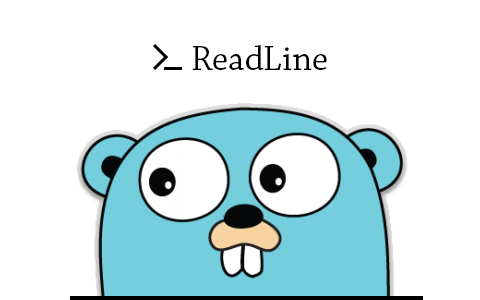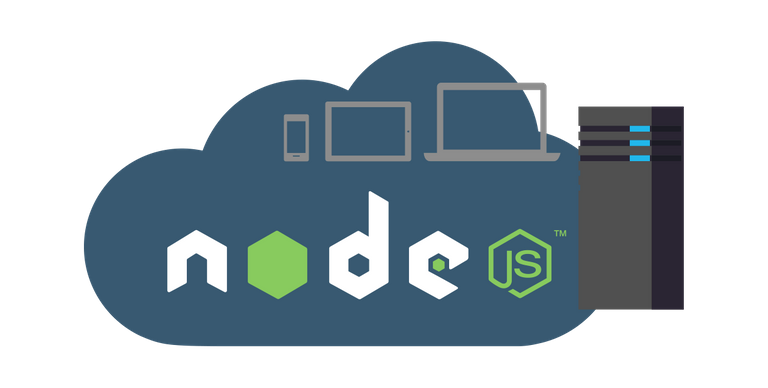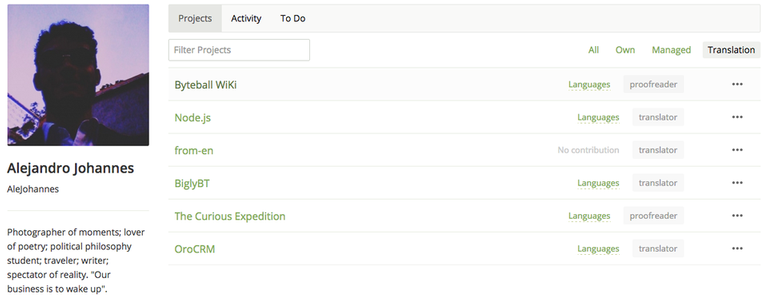Github Repository
https://github.com/nodejs/i18n
Project Details
By definition, Node.js is a Java Runtime Environment (JRE). But it is more than just that. While common JREs function as machine backups that allow users to smoothly run JavaScript on their browsers and applications, this open-source project functions as an app that manages Java code by itself. It's practical uses for developers are endless. It grants an extraordinarily versatile platform for designing code, programs, websites and other applications. And that isn't all: Node provides a virtual facility for testing the proper work of Java-driven programs and devices –and their planned updates–, helping to find bugs, solve errors, fix code and vastly improving their performance.
I believe all the amazing uses of Node are to be considered by themselves and I declare myself a fan of the project. But, besides, I support it for its functionality as a medium for bringing to reality countless creations that can be as good as Node itself. If you can dream it –and code it in JavaScript–, then your imagination is the only limit!The open translation of Node to thirty-three (33) languages proves the advantages of open-source projects when it comes to diversification of knowledge and worldwide spreading of useful tools.
Ahead, there is the link of the program's webpage:
Contribution Specifications
Translation Overview
This is my 37th contribution to Node.js as a translator. For this collaboration, I finished my previous work, on the readline.md file of Node.js' version 6, which contains the documentation of the Readline implementation within the program, and fully translated the intl.md document of the same version, containing the specifications of Node’s internationalization support.
In my previous report, I explained what is Readline and its main uses in programs like Node.js. I’ll refer here an extract of said report:
"In JavaScript, Readline is a method that performs data streams reading line by line. When dealing with streams, users would get confused and unable to perform specific target operations within great chunks of data if developers wouldn’t have thought about methods that direct them to their main goals, ignoring the rest of the contents of said aggrupation of digital information."

For this collaboration, I’ll clarify what TTY streams are, being a concept that repeats throughout the whole document:



First of all, what is TTY?
TTYs are teletyped terminals. Yeah, as simple as that. But… What is the background of their usage? Lets dig a little bit into their history.
Their name comes from the adaptation made on typewriters to be able to distribute their information through long distances, basically for stock market real-time operations in the late XIX century. These machines were called stock tickers and eventually evolved to ASCII-based machines called teletypes. Below, you can see a classic teletype in the 40s:

These later became connected and utilized for the transmission of telegraphs. When they were widely used, computers had their boom and eventually started to operate with command lines, which allowed users to interact with their operating systems. And this is where it gets fun… The modern computing pioneers used teletypes as the Input-Output devices. Amazing.
Physical teletypes are now discontinued and are virtually useless. Even though, they gave their name and ways of working to the Unix and Unix-like command-line terminals... And these are heavily used by Node.js. The modern concept of TTY refers us to the command (and methods based on that command) that orders the print of the filename of the terminal connected to the input of a certain command line. TTY Streams are those that set data in constant interaction between the user’s shell and the program’s terminal, according to the module specifications defined by said user, and whose device driver work as an input-output interface (notice the connection with history? :) ) between the kernel and the hardware.

Now, about the other file I translated, I’ll explain what it is about. Internationalization Support. And what is it?... Any guess?
Alright, folks! In computing, internationalization is the process through which a software is made readable and reliable for use globally, in contrast with localization, which is the inverse process (making locally usable a globally used program). For internationalization languages, technical requirements, regional particularities need to be adapted so a locally designed program can be run anywhere or in specific target locations. What this brief document states are the specifications of Node that helps the writing of internationalized programs with it. They are:
Locale-sensitive or Unicode-aware functions in the ECMAScript Language Specification:
And:
All functionality described in the ECMAScript Internationalization API Specification (aka ECMA-402):
In addition, this document includes suggestions for the detection of internationalization support. Basically, what this states are tricks to find out if said support is present in a given compilation. They are all based on in-system searches for ICU (International Components for Unicode) properties, assuming that the existence of some of them imply that internationalization features are enabled… Very clever!

*(This is us, looking for the internationalization support after we get the tips from the Node.js' manual)
You can find out more about the aforementioned concepts here:
- https://docs.oracle.com/cd/E19253-01/817-2524/sysadmintty-3/index.html
- http://www.linusakesson.net/programming/tty/index.php
- https://unix.stackexchange.com/questions/5421/what-is-the-concept-behind-tty-in-linux
- https://en.wikipedia.org/wiki/Tty_(unix)
- https://whatis.techtarget.com/definition/internationalization-I18N
- https://angular.io/guide/i18n
- https://en.wikipedia.org/wiki/Internationalization_and_localization
Thanks for taking your time to read! Expect more information and tips on the next report :)


Work example #01:
English:
The following example illustrates the use of <0>readline.Interface</0> class to
implement a small command-line interface
Spanish:
El siguiente ejemplo ilustra el uso de la clase <0>readline.Interface</0> para implementar una interfaz de línea de comandos pequeña
Work example #02:
English:
Because it is expected that most Node.js users will make use of only a small portion of ICU functionality, only a subset of the full ICU data set is provided by Node.js by default.
Spanish:
Ya que se espera que la mayoría de los usuarios de Node.js hagan uso solo de una porción pequeña de la funcionalidad de ICU, por defecto, nada más un subconjunto de la totalidad de los datos de ICU es proporcionada por Node.js.
Work example #03:
English:
This option makes the resulting binary link against the ICU library statically,
and includes a subset of ICU data (typically only the English locale) within
the <0>node</0> executable.
Spanish:
Esta opción hace que el enlace binario contra la librería de ICU resultante sea estático e incluya un subconjunto de datos de ICU (típicamente, solo la locale de inglés) dentro del ejecutable de <0>node</0>.
Languages
This translation was made from English to Spanish.
I got plenty experience translating and proofreading this project as an Utopian contributor. I collaborate here as translator and Language Moderator of the Da-Vinci/Utopian Spanish translation team. Besides this project, I have experience translating and proofreading The Curious Expedition, Ancap-ch, Byteball Wiki, OroCrm and BiglyBT.
Word Count
- The amount of words translated in this contribution is: 1,203.
Note: This number is the result of subtracting the complete sum of non-translatable content to the word-count Crowdin has done for the period in which this contribution was done.
- The total amount of words translated in this project (as a Da-vinci/Utopian translator) is: 46,150.
Previous Translations of the Project
- Contribution N'01. Submitted on September 13th, 2018.
- Contribution N'02. Submitted on September 15th, 2018.
- Contribution N'03. Submitted on September 17th, 2018.
- Contribution N'04. Submitted on September 19th, 2018.
- Contribution N'05. Submitted on September 21th, 2018.
- Contribution N'06. Submitted on September 22th, 2018.
- Contribution N'07. Submitted on September 23th, 2018.
- Contribution N'08. Submitted on October 1st, 2018.
- Contribution N'09. Submitted on October 8th, 2018.
- Contribution N'10. Submitted on October 14th, 2018.
- Contribution N'11. Submitted on October 15th, 2018.
- Contribution N'12. Submitted on October 18th, 2018.
- Contribution N'13. Submitted on October 21st, 2018.
- Contribution N'14. Submitted on October 24th, 2018.
- Contribution N'15. Submitted on October 27th, 2018.
- Contribution N'16. Submitted on October 31th, 2018.
- Contribution N'17. Submitted on November 3rd, 2018.
- Contribution N'18. Submitted on November 4th, 2018.
- Contribution N'19. Submitted on November 6th, 2018.
- Contribution N'20. Submitted on November 17th, 2018.
- Contribution N'21. Submitted on November 24th, 2018.
- Contribution N'22. Submitted on December 7th, 2018.
- Contribution N'23. Submitted on December 15th, 2018.
- Contribution N'24. Submitted on December 20th, 2018.
- Contribution N'25. Submitted on December 26th, 2018.
- Contribution N'26. Submitted on December 28th, 2018.
- Contribution N'27. Submitted on December 30th, 2018.
- Contribution N'28. Submitted on January 9th, 2019.
- Contribution N'29. Submitted on January 10th, 2019.
- Contribution N'30. Submitted on January 12th, 2019.
- Contribution N'31. Submitted on January 18th, 2019.
- Contribution N'32. Submitted on January 19th, 2019.
- Contribution N'33. Submitted on January 24th, 2019.
- Contribution N'34. Submitted on January 28th, 2019.
- Contribution N’35. Submitted on January 31st, 2019.
- Contribution N’36. Submitted on March 3rd, 2019.
Proof of Authorship
This translation was made between March 3rd and 4th*. You can check the translation record in my Crowdin account [here], the activity on the project's Crowdin [here] and a summary of recent additions to the project [here].


Hi @alejohannes,
Thank you for submitting your contribution!
Node.js is a very interesting project that contains many code values and terms related to computer science. Its difficulty relies on the fact that we must pay a lot of attention to the code in order to deliver the most accurate translation possible.
Your presentation post is informative, provides useful and relevant information, as well as your personal feedback in a very dynamic way. The visual presentation of the post is also very good and fun to read.
Kudos for always adding your personal touch to the report.
Your wording and spelling are correct and appropriate for the Spanish language and for the project.
Congratulations! :)
Your contribution has been evaluated according to Utopian policies and guidelines, as well as a predefined set of questions pertaining to the category.
To view those questions and the relevant answers related to your post, click here.
Chat with us on Discord
Thank you for your review, @marugy99! Keep up the good work!
Hi @alejohannes!
Your post was upvoted by @steem-ua, new Steem dApp, using UserAuthority for algorithmic post curation!
Your post is eligible for our upvote, thanks to our collaboration with @utopian-io!
Feel free to join our @steem-ua Discord server
Hey, @alejohannes!
Thanks for contributing on Utopian.
We’re already looking forward to your next contribution!
Get higher incentives and support Utopian.io!
Simply set @utopian.pay as a 5% (or higher) payout beneficiary on your contribution post (via SteemPlus or Steeditor).
Want to chat? Join us on Discord https://discord.gg/h52nFrV.
Vote for Utopian Witness!